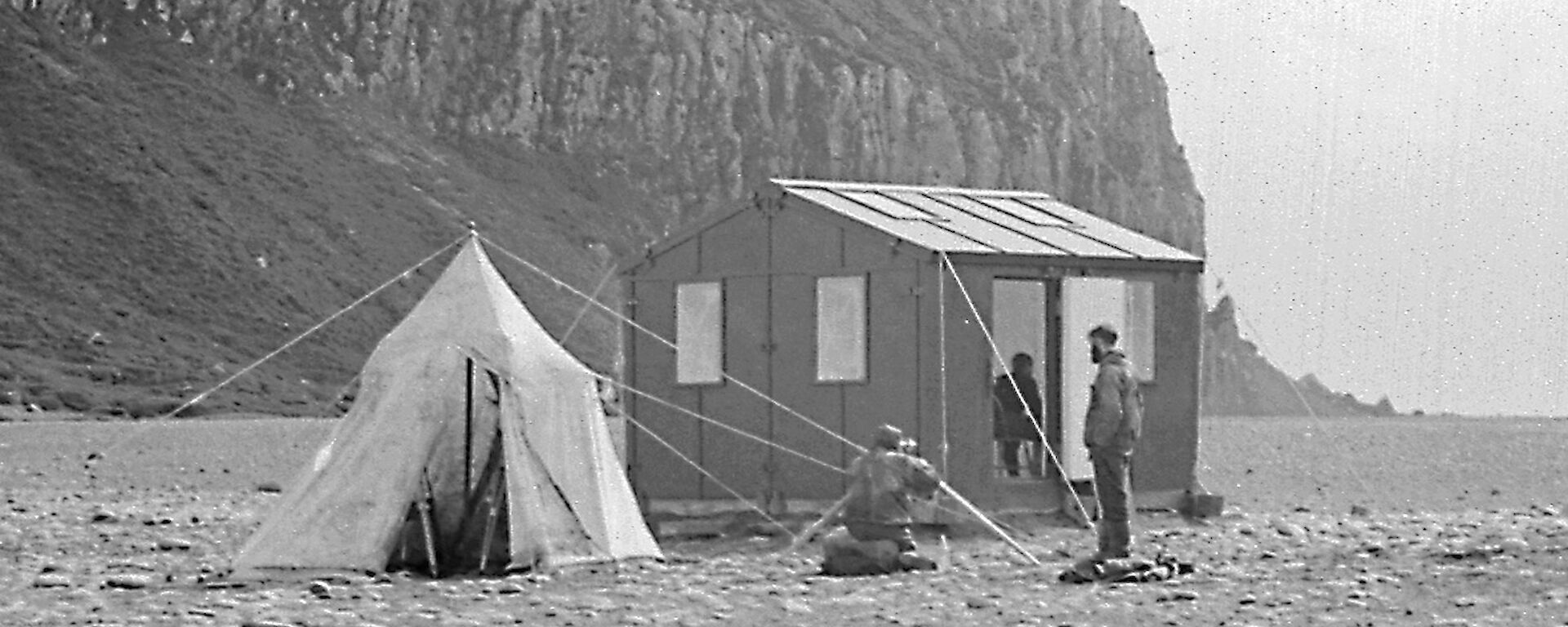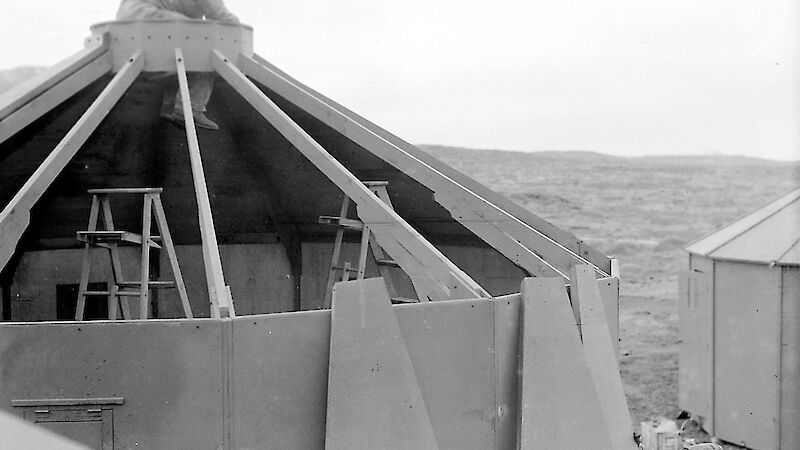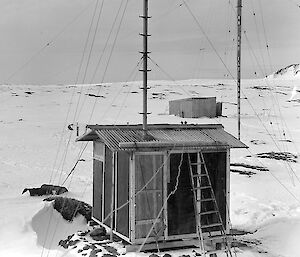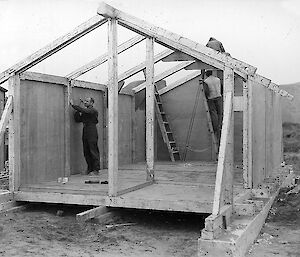Huts erected by the first Australian National Antarctic Research Expedition (ANARE) to Heard Island in 1947 were soon to prove inadequate for the harsh conditions. This led to innovative approaches to hut design and a string of developments for building design in Antarctica. The hastily organised expedition to Heard Island in 1947 initially utilised Second World War surplus supplies. It was realised that there was a need for much better and more reliable huts.
In 1947 there were two types of huts deployed at Atlas Cove along side the Admiralty hut originally erected in 1927. One type was the fourteen-sided plywood sandwich panel with fibre-glass insulation, often referred to as Alaskan huts. The other type was the ex-Royal Australian Air Force Borden prefabricated hut externally lined with masonite and with no insulation. The Borden huts had been designed for the tropics with ventilation panels at the top and bottom of the wall panels. To these two basic prefabricated building types there were a number of tailored extensions, adaptations, and even whole huts constructed from packing cases or scrounged, salvaged and recycled material at Heard Island. The various cold porches and the D-4 Tractor garage are two examples.
In 1950, 1951 and 1953, following a major development in building technology of prefabricated insulated huts, new huts were placed at Heard and Macquarie Islands. These reflected the need to have reliable, convenient huts that were easy to transport by boat and land in an amphibious vehicle (DUKW’s), quick to erect by unskilled labour, easy to maintain and efficiently insulated.
The breakthrough in design came with the ANARE Mark 1 generally known as the Meteorological, Recreational or Seismic hut. The Mark 1 huts were so successfully insulated that condensation built up in them and a small ventilator had to be devised to overcome the problem. These huts were stress skin plywood with integral isolite insulation panels set in an Oregon timber portal frame structure. They combined the good points of the existing huts — plywood stress skin construction like the 14 sided huts, but a simple building form like the Borden huts. The huts employed refrigeration cool store construction techniques of the time. They measured 3.8m by 7.6m (12 ft by 24 ft). Mawson expeditioners will recognise these buildings as the Met/Tech and Weddell huts, which were relocated to Mawson from Heard Island in 1955.
The Recreation hut at Heard Island is an ANARE Mark 1 hut and, while it is a little the worse for wear, it is still standing. The Met/Tech hut from Mawson, originally deployed on Heard Island, is proposed to be returned to Australia for future display at Queen Victoria Museum in Launceston.
The ANARE Mark 1 design was further refined in 1951 producing a simpler joint detail, making the panels structural and avoiding the need for a frame. The Absolute Magnetic hut and the Variometer hut at Heard Island are examples of this design. These huts were originally erected at Windy City West Bay, Heard Island.
The major inovation in this design was that the panels became structural and were tongue and grooved together. This technique was subsequently employed in the post tension boxes known as the PTBs which appeared as the ANARE Mark 3 in 1954. This inovation made the hut easier to erect and provided a superior joint in terms of wind, grit, rain and water shedding.
The early buildings that remain provide not just a testament to past activities and operations, but also an opportunity to understand materials performance in these environments. There are important insights to be gained by observation and testing. These buildings certainly provide some surprises to the durability and ecological sustainability of insulated plywood panel constructions in Antarctica. This relatively low level of technological sophistication by today’s standards, has outlasted later designs that corroded or failed in the same environments.
The AAD is currently completing an assessment of Atlas Cove Station on Heard Island and this will be available on the AAD’s Web site. Further studies are being undertaken into the Macquarie Island Station in the ANARE period and Wilkes Station between 1957–1969. The AAD is interested in comparative assessments and experiences of expeditioners.
Huts erected by the first Australian National Antarctic Research Expedition (ANARE) to Heard Island in 1947 were soon to prove inadequate for the harsh conditions. This led to innovative approaches to hut design and a string of developments for building design in Antarctica. The hastily organised expedition to Heard Island in 1947 initially utilised Second World War surplus supplies. It was realised that there was a need for much better and more reliable huts.
In 1947 there were two types of huts deployed at Atlas Cove along side the Admiralty hut originally erected in 1927. One type was the fourteen-sided plywood sandwich panel with fibre-glass insulation, often referred to as Alaskan huts. The other type was the ex-Royal Australian Air Force Borden prefabricated hut externally lined with masonite and with no insulation. The Borden huts had been designed for the tropics with ventilation panels at the top and bottom of the wall panels. To these two basic prefabricated building types there were a number of tailored extensions, adaptations, and even whole huts constructed from packing cases or scrounged, salvaged and recycled material at Heard Island. The various cold porches and the D-4 Tractor garage are two examples.
In 1950, 1951 and 1953, following a major development in building technology of prefabricated insulated huts, new huts were placed at Heard and Macquarie Islands. These reflected the need to have reliable, convenient huts that were easy to transport by boat and land in an amphibious vehicle (DUKW’s), quick to erect by unskilled labour, easy to maintain and efficiently insulated.
The breakthrough in design came with the ANARE Mark 1 generally known as the Meteorological, Recreational or Seismic hut. The Mark 1 huts were so successfully insulated that condensation built up in them and a small ventilator had to be devised to overcome the problem. These huts were stress skin plywood with integral isolite insulation panels set in an Oregon timber portal frame structure. They combined the good points of the existing huts’ plywood stress skin construction like the 14 sided huts, but a simple building form like the Borden huts. The huts employed refrigeration cool store construction techniques of the time. They measured 3.8m by 7.6m (12ft. by 24 ft.). Mawson expeditioners will recognise these buildings as the Met/Tech and Weddell huts, which were relocated to Mawson from Heard Island in 1955.
The Recreation hut at Heard Island is an ANARE Mark 1 hut and, while it is a little the worse for wear, it is still standing. The Met/Tech hut from Mawson, originally deployed on Heard Island, is proposed to be returned to Australia for future display at Queen Victoria Museum in Launceston.
The ANARE Mark 1 design was further refined in 1951 producing a simpler joint detail, making the panels structural and avoiding the need for a frame. The Absolute Magnetic hut and the Variometer hut at Heard Island are examples of this design. These huts were originally erected at Windy City West Bay, Heard Island.
The major inovation in this design was that the panels became structural and were tongue and grooved together. This technique was subsequently employed in the post tension boxes known as the PTBs which appeared as the ANARE Mark 3 in 1954. This inovation made the hut easier to erect and provided a superior joint in terms of wind, grit, rain and water shedding.
The early buildings that remain provide not just a testament to past activities and operations, but also an opportunity to understand materials performance in these environments. There are important insights to be gained by observation and testing. These buildings certainly provide some surprises to the durability and ecological sustainability of insulated plywood panel constructions in Antarctica. This relatively low level of technological sophistication by today’s standards, has outlasted later designs that corroded or failed in the same environments.
The AAD is currently completing an assessment of Atlas Cove Station on Heard Island and this will be available on the AAD’s website. Further studies are being undertaken into the Macquarie Island Station in the ANARE period and Wilkes Station between 1957–1969. The AAD is interested in comparative assessments and experiences of expeditioners.
If you have a collection of Antarctic expedition diaries or photographs or know of such a collection then Robert Vincent, the Cultural Heritage Manager, would appreciate if you would get in touch with him and make it available for copying by the Division. Alternatively you should consider depositing them in the National or a State Archive.
Robert Vincent
Cultural Heritage Manager,
Australian Antarctic Division





